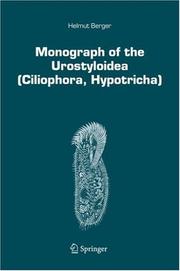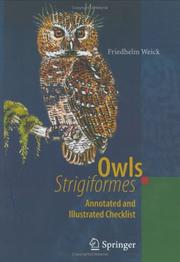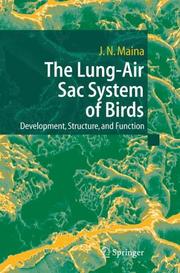| Listing 1 - 10 of 110 | << page >> |
Sort by
|
Book
ISBN: 1421438232 9781421438245 9781421438238 1421438240 Year: 2020 Publisher: Baltimore Baltimore, Md.
Abstract | Keywords | Export | Availability | Bookmark
 Loading...
Loading...Choose an application
- Reference Manager
- EndNote
- RefWorks (Direct export to RefWorks)
"Author Gordon Rodda has created the first comprehensive compilation of the natural history and ecology of all the world's lizards. He presents an alternative taxonomic understanding of lizards that will challenge received wisdom. This unparalleled informational source will be an essential reference work for reptile scientists and students of herpetology"--
Animals --- Lizards --- Lacertilia --- Lacertilian reptiles --- Lacertilians --- Sauria --- Squamata --- Animal classification --- Animal systematics --- Animal taxonomy --- Classification --- Systematic zoology --- Systematics (Zoology) --- Taxonomy, Animal --- Zoological classification --- Zoological systematics --- Zoological taxonomy --- Zoology --- Lizards - Identification --- Animals - Classification

ISBN: 1280864915 9786610864911 1402052731 1402052723 Year: 2006 Volume: v. 85 Publisher: Dordrecht, the Netherlands : Springer,
Abstract | Keywords | Export | Availability | Bookmark
 Loading...
Loading...Choose an application
- Reference Manager
- EndNote
- RefWorks (Direct export to RefWorks)
This monograph is the second of a series treating the hypotrichs, a major part of the spirotrichous ciliates. The urostyloids are characterised by a zigzag-arrangement of the ventral cirri. Like the first part of the series, the Oxytrichidae, it summarises the morphological, morphogenetic, faunistic, and ecological data from the past 230 years, scattered in more than 1300 references from all over the world. Dichotomous keys lead to 36 genera and subgenera comprising 153 species illustrated by more than 2100 figures, including original ones. The treatise offers taxonomists, cell biologists, and
Hypotrichida --- Hypotricha --- Hypotrichia --- Hypotrichina --- Hypotrichorida --- Hypotrichous ciliates --- Hypotrichs --- Spirotricha --- Invertebrates. --- Aquatic biology. --- Zoology. --- Freshwater & Marine Ecology. --- Animal Systematics/Taxonomy/Biogeography. --- Biology --- Natural history --- Animals --- Hydrobiology --- Water biology --- Aquatic sciences --- Invertebrata --- Aquatic ecology . --- Animal systematics. --- Animal taxonomy. --- Animal classification --- Animal systematics --- Animal taxonomy --- Classification --- Systematic zoology --- Systematics (Zoology) --- Taxonomy, Animal --- Zoological classification --- Zoological systematics --- Zoological taxonomy --- Zoology --- Aquatic biology --- Ecology

ISBN: 1281043990 9786611043995 3540395679 3540352341 3642071228 Year: 2006 Publisher: Berlin ; New York : Springer,
Abstract | Keywords | Export | Availability | Bookmark
 Loading...
Loading...Choose an application
- Reference Manager
- EndNote
- RefWorks (Direct export to RefWorks)
The owl is a magical creature: it exudes an ambivalent fascination that can trigger completely antithetical responses. On the one hand, there is something unsettling about the owl’s soundless flight, eerie call, and nocturnal activity that can result in its demonization as a messenger of darkness. On the other hand, however, its masklike visage and seemingly penetrating gaze prove - thralling, and this may have contributed to the deification of the owl as the companion spirit of an omniscient mother earth. In addition, the highly s- cialized captor of prey aroused the competitive envy of hunting parties, even provoking a bit of resentment when they lost out to owls in their hunt for small game. Moreover, the excrement and pellets (hairballs) they deposited in barns and church towers contributed to their reputation as undesirables or even pests. With the overcoming of superstition and suspicion, our relati- ship with these creatures of the night has now become one of unreserved - miration. They grant us insights into the rich diversity of adaptation to n- turnal hunting as well as into sound inventories, brooding biology, and ne- ling development. In a complete transformation of what was once a symbol of fear and hatred, charismatic owls now enjoy an almost singular popularity in large parts of the population.
Owls --- Striges --- Strigiformes --- Birds --- Zoology. --- Vertebrates. --- Biodiversity. --- Animal Systematics/Taxonomy/Biogeography. --- Biological diversification --- Biological diversity --- Biotic diversity --- Diversification, Biological --- Diversity, Biological --- Biology --- Biocomplexity --- Ecological heterogeneity --- Numbers of species --- Vertebrata --- Chordata --- Natural history --- Animals --- Animal systematics. --- Animal taxonomy. --- Animal classification --- Animal systematics --- Animal taxonomy --- Classification --- Systematic zoology --- Systematics (Zoology) --- Taxonomy, Animal --- Zoological classification --- Zoological systematics --- Zoological taxonomy --- Zoology
Book
ISBN: 354072446X 3540724451 3642091520 Year: 2008 Publisher: Berlin ; New York : Springer,
Abstract | Keywords | Export | Availability | Bookmark
 Loading...
Loading...Choose an application
- Reference Manager
- EndNote
- RefWorks (Direct export to RefWorks)
Lagomorphs are a mammalian order which includes rabbits, hares and pikas. They are distributed throughout the world and are of both scientific and public interest as they are classified between endangered and pest species. In addition, some have a high economic value as important game species. In the last few decades, a huge amount of information was made available to the scientific community and resulted in remarkable advances on all aspects of Lagomorph biology. However, this information is dispersed in multiple scientific and non-scientific journals. This book provides an updated synthesis of the current knowledge on Lagomorph biology.
Lagomorpha. --- Lagomorphs --- Duplicidentata --- Mammals --- Zoology. --- Animal ecology. --- Animal Ecology. --- Animal Systematics/Taxonomy/Biogeography. --- Animals --- Zoology --- Ecology --- Biology --- Natural history --- Animal systematics. --- Animal taxonomy. --- Animal classification --- Animal systematics --- Animal taxonomy --- Classification --- Systematic zoology --- Systematics (Zoology) --- Taxonomy, Animal --- Zoological classification --- Zoological systematics --- Zoological taxonomy
Book
ISBN: 1402098065 9786612036293 1282036297 1402098073 Year: 2009 Publisher: [Dordrecht] : Springer,
Abstract | Keywords | Export | Availability | Bookmark
 Loading...
Loading...Choose an application
- Reference Manager
- EndNote
- RefWorks (Direct export to RefWorks)
This summary of the results of chromosomal analysis of various groups of parasitic wasps will be essential reading for those working in the field. It is the second edition of a monograph that was first published in Russian, and has been substantially updated with new data, conclusions and references. The goal of this ground-breaking work is to document the author’s study of the karyotype structure and chromosomal evolution of parasitic Hymenoptera. It also interprets the results obtained, from both routine and differential chromosome staining, for systematic and phylogenetic purposes. Despite the huge importance of parasitic wasps, many problems of their taxonomy remain insufficiently studied. This is a situation that needs rectifying, as Hymenoptera are one of the largest and most taxonomically complicated groups of insects and they play a very important role in food chains as parasitoids of the overwhelming majority of insects and other arthropods. Parasitic wasps attack many pests of agriculture and forestry as well as certain beneficial insects. In addition, some secondarily phytophagous Hymenoptera damage certain cultivated plants. The renowned entomologist and author of this volume, Vladimir Gokhman, has himself developed a particular technique for obtaining chromosomal preparations from adult parasitic wasps. This allowed the inclusion of a wide range of those insects into the study. The karyotypic features of the majority of superfamilies and families as well as many lower taxa of parasitic Hymenoptera are listed, while the plesiomorphic and apomorphic character states of chromosome sets of parasitic wasps are revealed. The structural features of karyotypes used for identifying and discriminating sibling species and similar forms are shown, as are the data on chromosome sets of about 400 species of parasitic Hymenoptera (including more than 200 micrographs). Also included is a comprehensive phylogenetic and taxonomic analysis of karyotypic information. This book is unique because it demonstrates a range of karyotypic data for an insect group that seemed unattainable in this respect not so long ago. Rich in new facts, techniques and ideas, it will be of use to all those interested in karyology and Hymenoptera.
Hymenoptera --Genetics. --- Karyotypes. --- Parasitic wasps --Genetics. --- Parasitic wasps --- Karyotypes --- Hymenoptera --- Invertebrates & Protozoa --- Zoology --- Health & Biological Sciences --- Genetics --- Hymenoptera. --- Symphyta --- Life sciences. --- Animal genetics. --- Entomology. --- Life Sciences. --- Animal Genetics and Genomics. --- Animal Systematics/Taxonomy/Biogeography. --- Insects --- Chromosome abnormalities --- Chromosomes --- Cytotaxonomy --- Animal systematics. --- Animal taxonomy. --- Animal classification --- Animal systematics --- Animal taxonomy --- Classification --- Systematic zoology --- Systematics (Zoology) --- Taxonomy, Animal --- Zoological classification --- Zoological systematics --- Zoological taxonomy --- Animals
Book
ISBN: 3319204564 3319204572 Year: 2015 Publisher: Cham : Springer International Publishing : Imprint: Springer,
Abstract | Keywords | Export | Availability | Bookmark
 Loading...
Loading...Choose an application
- Reference Manager
- EndNote
- RefWorks (Direct export to RefWorks)
Inchworms, tiger moths, underwings, owlet moths, silkworms,sphinx moths, grass moths, and butterflies. Collectively, these and many others are the Lepidoptera, one of the most diverse groups of animals on the planet. Lepidoptera can be found in the highest tropical canopies,the driest deserts, and at the leading edge of science. The adults include some of the most beautiful insects that have inspired artists and have sailed through the dreams of human cultures for millennia. The immature stages (“caterpillars”), like the underwing depicted on the cover, link together vital processes in diverse terrestrial ecosystems that are only barely documented let alone understood. The people that study these animals are lepidopterists, and the goal of this book is to introduce them with their own words. In twenty chapters, lepidopterists tell their stories, and these tales mirror the diversity of nature in their range and depth. You will find individuals that wrestle with the challenges of scientific careers, stories of far flung travel sand close calls, and historical perspectives on recent decades of scientific break throughs.
Biology - General --- Biology --- Health & Biological Sciences --- Science --- Popular works. --- Applied ecology. --- Entomology. --- Popular Science. --- Popular Life Sciences. --- Animal Systematics/Taxonomy/Biogeography. --- Applied Ecology. --- Ecology --- Environmental protection --- Nature conservation --- Insects --- Zoology --- Life sciences. --- Animal systematics. --- Animal taxonomy. --- Animal classification --- Animal systematics --- Animal taxonomy --- Classification --- Systematic zoology --- Systematics (Zoology) --- Taxonomy, Animal --- Zoological classification --- Zoological systematics --- Zoological taxonomy --- Biosciences --- Sciences, Life --- Animals
Book
ISBN: 3319744178 3319744186 Year: 2018 Publisher: Cham : Springer International Publishing : Imprint: Springer,
Abstract | Keywords | Export | Availability | Bookmark
 Loading...
Loading...Choose an application
- Reference Manager
- EndNote
- RefWorks (Direct export to RefWorks)
This volume merges all geographical and paleogeographical data on all groups of the arachnofauna. The book features topics such as the ecological factors, climate and other barriers that influence the distribution of arachnida. It also elaborates on the characteristics of the distribution such as arachnida at high altitude (e.g. Himalaya), in caves, in polar regions and highlights differences between the arachnofauna of e.g. Mediterranean regions vs Central Europe, West African vs Indomalayan and more. Furthermore, amongst other topics the volume also includes chapters on the systems of arachnida, fossil orders, dispersal and dispersion, endemics and relicts, regional arachnogeography, cave and high altitude arachnida.
Arachnida --- Geographical distribution. --- Arachnids --- Arthropoda --- Entomology. --- Vertebrates. --- Animal ecology. --- Animal Systematics/Taxonomy/Biogeography. --- Animal Ecology. --- Animals --- Zoology --- Ecology --- Vertebrata --- Chordata --- Insects --- Animal systematics. --- Animal taxonomy. --- Animal classification --- Animal systematics --- Animal taxonomy --- Classification --- Systematic zoology --- Systematics (Zoology) --- Taxonomy, Animal --- Zoological classification --- Zoological systematics --- Zoological taxonomy

ISBN: 1280413034 9786610413034 3540297278 3540255958 3642065015 Year: 2005 Publisher: Berlin : Springer-Verlag,
Abstract | Keywords | Export | Availability | Bookmark
 Loading...
Loading...Choose an application
- Reference Manager
- EndNote
- RefWorks (Direct export to RefWorks)
In biology, few organs have so eluded understanding as the lung-air sac system of birds. Considerable progress recently has been made in filling the gaps in knowledge, however. While summarizing and building on earlier observations and ideas, this book provides cutting-edge details on the development, structure, function, and evolutionary design of the avian respiratory system. Outlining the mechanisms and principles through which biological complexity and functional novelty have been crafted in a unique gas exchanger, this account will provoke further inquiries on the many still-unanswered questions. The specific goal of the book is to highlight the uniqueness of the design of the avian respiratory system and the factors that led to its development.
Air sacs (Bird anatomy) --- Birds --- Respiratory organs. --- Air-sacs (of birds) --- Sacs, Air (Bird anatomy) --- Respiratory organs --- Animal physiology. --- Zoology. --- Morphology (Animals). --- Animal Physiology. --- Animal Anatomy / Morphology / Histology. --- Animal Systematics/Taxonomy/Biogeography. --- Biology --- Natural history --- Animals --- Animal morphology --- Body form in animals --- Zoology --- Morphology --- Animal physiology --- Anatomy --- Physiology --- Animal anatomy. --- Animal systematics. --- Animal taxonomy. --- Animal anatomy --- Animal classification --- Animal systematics --- Animal taxonomy --- Classification --- Systematic zoology --- Systematics (Zoology) --- Taxonomy, Animal --- Zoological classification --- Zoological systematics --- Zoological taxonomy
Book
ISBN: 1281397873 9786611397876 1402081766 1402081758 9048177936 Year: 2008 Publisher: Dordrecht ; London : Springer,
Abstract | Keywords | Export | Availability | Bookmark
 Loading...
Loading...Choose an application
- Reference Manager
- EndNote
- RefWorks (Direct export to RefWorks)
This work was begun to provide keys to the aquatic insect species known from Brazil. The original goal was to include all genera known from South America and all species from Brazil, but for most groups, the scope was expanded to encompass all species in South America, and, in some cases, to include terrestrial species of orders that include both terrestrial and aquatic taxa. In no case is a taxonomic revision of any group undertaken, although recommendations for such revisions are included where appropriate, and the probable synonymy of nominal species still treated as valid in the literature is noted. Two different approaches will be employed according to the taxon being treated. For phylogenetic groups encompassing overwhelmingly or exclusively aquatic species, such as the orders Plecoptera and Ephemeroptera or the families Dytiscidae and Culicidae, keys are provided to distinguish all genera and species known to occur in South America. An effort has been made to include every identifiable species so that the user of the key can determine with reasonable certainty whether or not his specimen belongs to a species that has already been described or whether it is one that is not yet known to science. Where feasible, complete keys will be prepared for groups containing both aquatic and terrestrial species that do not encompass an extraordinarily large number of species. This has already been done for the order Collembola.
Aquatic insects --- Damselflies --- Damsel flies --- Zygoptera --- Odonata --- Insects, Aquatic --- Water insects --- Aquatic invertebrates --- Insects --- Entomology. --- Zoology. --- Aquatic biology. --- Animal ecology. --- Freshwater & Marine Ecology. --- Animal Systematics/Taxonomy/Biogeography. --- Animal Ecology. --- Animals --- Zoology --- Ecology --- Hydrobiology --- Water biology --- Aquatic sciences --- Biology --- Natural history --- Aquatic ecology . --- Animal systematics. --- Animal taxonomy. --- Animal classification --- Animal systematics --- Animal taxonomy --- Classification --- Systematic zoology --- Systematics (Zoology) --- Taxonomy, Animal --- Zoological classification --- Zoological systematics --- Zoological taxonomy --- Aquatic biology
Book
ISBN: 1281512524 9786611512521 1402082398 140208238X Year: 2008 Publisher: New York : Springer,
Abstract | Keywords | Export | Availability | Bookmark
 Loading...
Loading...Choose an application
- Reference Manager
- EndNote
- RefWorks (Direct export to RefWorks)
The third edition of The Ciliated Protozoa continues the innovative approach of the previous two editions, thoroughly documenting the progress in our understanding of the evolutionary diversification of these widely distributed eukaryotic microorganisms. The Glossary is considerably revised and expanded, serving as an illustrated ‘subject index’ of more than 700 terms. An introduction to the phylum is followed by chapters on the 11 classes. Each class chapter contains 7 sections: taxonomic structure life history and ecology somatic structures oral structures division and morphogenesis nuclei, sexuality, and life cycle other features The book includes new data on the ultrastructure of the somatic cortex of each class, molecular phylogenetics, ecology, and on other important aspects of ciliate biology. These new data are used, along with a novel conceptual approach, to rationalize a new system of classification for the phylum, presented in a major chapter on The Ciliate Taxa. The book includes an up-to-date bibliography of approximately 3,000 citations to both the ‘classical’ and recent literature, and both a Subject Index and a Systematic Index. This unique and timely book will serve as a comprehensive and authoritative reference work for students, teachers, and researchers who have an interest in the protozoa, and particularly the ciliates. As an additional feature, all figures are available electronically for free viewing on the book's homepage at www.springer.com/978-1-4020-8238-2, under Additional Information. .
Ciliata --- Ciliated protozoa --- Ciliophora --- Protozoa --- Invertebrates. --- Microbiology. --- Ecology. --- Microbial ecology. --- Cytology. --- Eukaryotic Microbiology. --- Animal Systematics/Taxonomy/Biogeography. --- Microbial Ecology. --- Cell Biology. --- Cell biology --- Cellular biology --- Biology --- Cells --- Cytologists --- Environmental microbiology --- Microorganisms --- Ecology --- Microbiology --- Balance of nature --- Bionomics --- Ecological processes --- Ecological science --- Ecological sciences --- Environment --- Environmental biology --- Oecology --- Environmental sciences --- Population biology --- Microbial biology --- Invertebrata --- Animals --- Animal systematics. --- Animal taxonomy. --- Ecology . --- Cell biology. --- Animal classification --- Animal systematics --- Animal taxonomy --- Classification --- Systematic zoology --- Systematics (Zoology) --- Taxonomy, Animal --- Zoological classification --- Zoological systematics --- Zoological taxonomy --- Zoology
| Listing 1 - 10 of 110 | << page >> |
Sort by
|

 Search
Search Feedback
Feedback About UniCat
About UniCat  Help
Help News
News